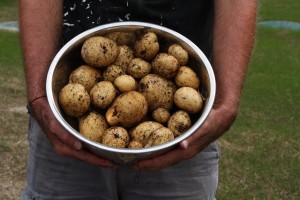Learn about potatoes, including how to plant and grow them.
Listen to podcast:
I still remember helping pick potatoes (Solanum tuberosum) on my grandfather’s farm. It was hard work, but the rewards were tasty spuds all winter long. Since potatoes are also readily available in stores and relatively inexpensive, you may wonder, why grow your own. Well, like all vegetables, fresh potatoes dug from your own soil taste better and you can grow a wider variety of potatoes than you’ll find in a grocery
store. Some of these varieties have yellow, red, or even purple flesh. You don’t need a farm to grow potatoes, either. You can grow potatoes in a small bed or even a container.
When to Plant
Potatoes thrive with cool, moist conditions. Plant the seed potatoes (small tubers) 2 to 4 weeks before your last frost date — April or May.
Where to Plant
Potatoes grow best in full sun, but you still can get a crop if your garden only gets 3 to 4 hours of sun a day. Plant in well drained, fertile soil in the garden or a container.
How to Plant
Potatoes grow best in soil rich in phosphorous and potassium. Based on a soil test, make sure your soil has plenty of both. Potatoes aren’t planted from seed, but from small tubers called seed potatoes. Buy these locally or through the mail. Don’t use store bought spuds as seed potatoes because they are treated with a sprout inhibitor to slow growth and may have diseases on them.
Potatoes are planted in a trench dug 6 inches deep. Place seed potatoes spaced 1 foot apart in rows spaced 2 feet apart. Fill the trench with just enough soil to cover the seed potatoes. Water well.
You can also plant 4 seed potatoes in a bottom of a 15 gallon tub, potato bag, or plastic barrel. Fill the tub with potting soil so it covers the seed potatoes. As they grow continue to add more soil until you reach the top. Keep well watered.
Care and Maintenance
Once the potatoes sprout and are 6 inches tall, mound soil over them with a hoe. Do this a second time 2 weeks later. Hilling not only creates more area for potatoes to develop in the soil, it’s a fast way to weed, and it shades the developing tubers from the sun so they don’t turn green. Green skinned potatoes are off flavored and mildly toxic.
After the second hilling mulch the rows and hills with a layer of straw or untreated grass clippings. If you can keep the soil evenly moist, you’ll get bigger and more tubers forming.
Colorado potato beetles love to eat potato leaves. Crush the orange eggs on the underside of the leaves, spray B.t. ‘San Diego’ on the red, soft bodied larvae, and hand pick the adults. Keep the pH around 6 to avoid potato scab disease and plant disease free seed potatoes to avoid late blight. Remove any left over sprouting potatoes from last to reduce diseases.
Harvest
Potatoes take about 70 to 90 days to mature, but you can harvest new potatoes 6 weeks after planting. New potatoes are baby spuds that you “steal” from the hill by lightly digging around by hand. Don’t take too many or you’ll reduce your yield later. Mature potatoes are harvested when the tops start to yellow and die. Pull up the entire plant and pick the potatoes attached to the vine and left in the surrounding soil. Turn over potato containers and pick through the soil for these spuds. Eat any damaged tubers first and cure the rest in a 70F airy, shaded room for 2 weeks. Store in a cool, dark basement or garage for up to 6 months.
Additional Information
‘Yukon Gold’ is my favorite potato variety. It has moist yellow flesh and is great baked, boiled, or roasted. ‘All Red’ has red colored flesh and ‘All Blue’ has blue colored flesh. ‘Burbank’ is a good white fleshed baker and ‘Russian Banana’ is a good fingerling potato, perfect for roasting.
Text excepted from the Northeast Vegetable and Fruit Gardening book.
Podcast Transcript
If you thought potatoes were just those boring spuds found in bags in the grocery store, think again. Potatoes have a rich history and continue to be at the forefront of controversy around the world. This common global food has been the center of mass migrations of people and lawsuits challenging multi-national corporations. Not bad for an Andean spud.
Yes, potatoes hail from the Andes but now are grown around the world. What we know as the white, round potato, is really just one possible color and shape for potatoes. We’ve all seen the red, blue and finger-shaped varieties in markets. The beauty is all these varieties can be easily be grown in your garden. Try the ‘Adirondack Blue’ or ‘Adirondack Red’ varieties for their colorful skin and flesh. For a taste treat grow fingerling varieties. ‘Swedish Peanut’ and ‘Rose Finn’ are two varieties that have dry flesh, small shape and are great for roasting.
There are even varieties that are high in protein and vitamin C, such as Butte, and one that repels Colorado potato beetle. ‘King Harry’ is not-genetically modified. It has hairy leaves that potato beetles don’t like laying eggs on. The result is a delicious potato crop without needing sprays.
If you think you need acres to grow potatoes, try again. Using potato grow bags I was able to grow 13 pounds of spuds in a 3 foot diameter grow bag one summer. That’s a lot of baked potatoes and a tinier way to grow some spuds!
So include some unusual potatoes in your garden this summer. Many varieties will last into winter with proper storage and you’ll be making colorful mashed potatoes for the holidays.




